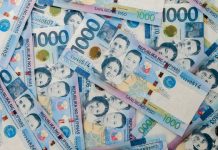When he inherited the 5-hectare farm in Eman, Bansalan, Davao del Sur from his mother, Benjamin R. Lao was a little bit apprehensive of its future since the area was barren. But the good thing was: coconut trees were growing. Every three months, he harvested from as low as 400 nuts to as high as 600 nuts.
Then a government employee, Lao considered himself a weekend farmer. So every Saturdays and Sunday, he went home to his farm and tried to develop it. At one time, he attended an agricultural training conducted by the Mindanao Baptist Rural Life Center (MBRLC) Foundation, Inc., just a few kilometers away from his farm.
After the training, he went home and brought with him seeds of various nitrogen-fixing legumes like Desmodium rensonii, Flemingia macrophylla, and Indigofera anil. Some few months later, he observed that his coconut trees were producing more nuts. In fact, he was able to harvest about 15,000 nuts per quarter.
However, Lao felt he was not maximizing income opportunities from his coconuts. So, instead of focusing only on copra (the dried coconut meat), he explored some ways to process the crop into other goods. “Coconut farmers only think of copra,” he said. “I had the notion that it wasn’t enough. I had to find a way to add value to the product.”
He consulted the Philippine Coconut Authority who advised him to find some healthy products from and how to produce them. Believing there was an untapped opportunity to produce and market coconut sugar and coconut syrup, he hired more people and started producing the healthier alternative sweeteners.
With the help from the Department of Science and Technology, he was able to do so. “As a farmer and sort of a scientist, I was able to focus on researching about coconut sap products,” he recalled. “It took me eight months to study on how to make export-quality coconut syrup.”
Lao registered his coconut products with the Department of Trade and Industry under the name “Donna Belle” (a combination of the names of his two daughters). He also explored generating high-quality charcoal and white copra using charcoal kilns to diversity his products.
Today, he is known as the man behind the company to export coconut syrup to the United States. He also developed a coconut sap-based teriyaki sauce which is exported to Germany and Australia.
Despite competition from Indonesian coco products exporters, who can sell their products at a much lower prices because of lower labor costs, Lao says buyers still prefer his products because of quality, particularly in terms of taste. Being certified by the United States Department of Agriculture and Europe also gives him an edge over competitors.
“Have a businessman’s mindset and always think of the future,” advised Lao, who has already received various awards and recognitions for his efforts. “Don’t be content with small things. Even if you’re from a small town, you can dream big things.”
Although not a native of the Philippines, coconut is considered as God’s gift to Filipinos. As one historian puts it: “A man sleeps in the shade of the tree. He is awakened when a nut falls, drinks the water, and eats some of the meat. He then feeds the rest of the meat to the chickens, which produce eggs, milk, and meat. The leaves provide thatch for the roof and walls of his coconut hut, and are also woven into hats, baskets, and mats.”
The Philippines used to be the world’s largest producer of coconuts until it was dislodged by Indonesia.
Currently, about 3.565 million hectares – or 26% of the country’s total agricultural lands – are planted to coconut. Out of 81 provinces, 68 of these are considered as coconut-growing areas. About 339 million bearing coconuts can be found throughout the country.
“About 26 million Filipinos depend on coconut trees for their livelihood,” said Dr. Jesus Lim Arranza, chairman of the Federation of Philippine Industries. “For the marginal coconut farmers, they depend mostly, if not entirely, on coconut for their need for food, clothing, shelter and education for their children.”
The coconut is one of the country’s dollar earners. “While coconut is one of the two agricultural commodities that earns the country more than a billion dollars in export revenues every year, its vast potential to earn even more has never been tapped because of numerous issues bugging the industry,” deplored Dr. William D. Dar, a former international administrator and now the president of Inang Lupa Movement which actively pursues urgent, collective, and cohesive action towards poverty alleviation, food and nutrition security, and economic prosperity.
For one, there’s an issue of low production. Nut production on the average was 13.8 million or 46 nuts per tree per year, according to Dar said. For another, most of the coconut trees grown in the country are now very old. In fact, 15 out of every 100 coconut trees are “past retirement age.” More than 44 million coconut trees are at least 60 years old.
Besides low yield per tree and aging trees, “the supply chain is largely unorganized and made up to dispersed small holdings that affects economies of scale in input supply, primary processing and marketing,” Dar noted.
The small production lots and high transport means “high costs of logistics, which affect both farmers and processors.” And in the global scene, he said, there are market threats from tariff and non-tariff barriers such as minimum residue levels and labeling regulations.
“Addressing low yields at the farm level can be an excellent move to helping realize the coconut industry’s potential as a bigger generator of export dollars,” Dar pointed out in his column appearing in a national daily.
He considered the 46 nuts per tree per year as “ridiculously low.” In comparison, India gets an average of 250 nuts per tree per year while in Mexico it goes up to 300 nuts and 400 nuts in Brazil.
“Obviously, the low yields are caused by poor genetics, nil fertilization, and limited replanting of tree stocks,” he said. “Also, 20% of coconut trees are already senile while most trees are planted in marginal lands that also affect yield. Meanwhile, large lands planted to the crop have low genetic potential.”
Dar recommended ramping up research and development efforts to improve the productivity of coconut trees. “In short, we need science-based solutions,” he said.
According to Dar, it is possible to increase productivity of coconut trees from 46 nuts per year to 150 nuts per year by using the hybrids developed by the Philippine Coconut Authority. “Also, 300 nuts can be achieved in well-managed plantations by augmenting hybrid technology with good agricultural practices,” he said.
Efforts on research and development must address not only low productivity but also pests and diseases, the establishment of post-harvest and processing facilities, value addition, crop diversification (crops and livestock integration) and soil mapping.
He also wanted agribusiness development to be pursued. “This will also include provision for credit and other risk management tools (like insurance and subsidy), so farmers and processors can pursue innovations that have potentials to improve the coconut industry,” he said.
For coconut farmers, Dar suggested that capacity development that are in sync with the changing dynamics of the coconut industry sector due to climate change, budget crunch, and earth of an effective and efficient extension education service be relentlessly pursued.
The coconut industry badly needs government support as the global demand for coconut is expected to grow in the future. With the problems besetting the coconut industry, it may just be a matter of time that the Philippines will again be taken over by other coconut-producing countries from its ranking as the second-biggest producer of coconut in the world.
“The timely intervention by the government on the issues now confronting the local coconut industry would be very crucial for its survival,” Arranza stressed.






